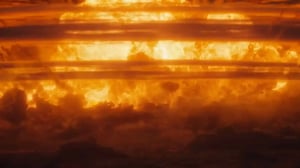
FX Artist - Film
TABLE OF CONTENTS
What does a film FX artist do?
An FX artist creates digital simulations and procedural workflows based on real-world elements or supernatural concepts that move or react under the basic laws of physics. These can be realistic or stylized, depending on the type of effect and how it’s used.
Composition, scale, form, speed, and viscosity are often taken into account to help determine how an effect looks and reacts to its surroundings. Before creating effects for film or TV, effects artists are often required to research real-life phenomena, watch reference videos (when possible), and generate multiple concepts.
FX artist job description
Smoke billowing from a burning building, a tidal wave crashing down on a beach, tree leaves swaying in the breeze, magic rays extending out from a magician’s wand — these effects are the responsibility of an FX artist. They also create explosions, destruction, particle systems, and liquid simulations. Their role can also be as broad as generating procedural environments, building basic assets, character FX, and solving challenging pipeline problems.
“As an FX artist, you need to excel at problem-solving — challenging problems that, sometimes, other departments can’t solve," says FX artist Daniel Hourigan, who is also the VFX Department Head and mentor of the FX course.
Role & responsibilities of an FX artist in film:
- Design and create FX animation, procedural simulations, dynamic simulations, particle and fluid systems
- Light and render FX elements and produce composites to showcase ideas and concepts
- Assist in setting up or maintaining a library of effects presets which can be loaded and applied to multiple shots.
- Generate and export compatible caches across various software
- Create tools and code to facilitate automated workflows

How much does an FX artist make?
Wages for FX artists start at around USD $74,000 and peak at around USD $138,000.
Skills required to become an FX artist
FX artists require a mix of technical, creative skills, and interpersonal skills. The VFX industry is a highly collaborative environment — a single shot will often travel through multiple departments before being “finaled” — so FX artists must be able to work well in a team and have a solid understanding of the VFX pipeline.
Film studios may look for the following skills in an FX artist:
- Houdini knowledge and experience (demonstrated via showreel)
- Ability to work in a fast-paced environment and work under pressure to meet tight deadlines and rapid turnaround times
- A solid understanding of the VFX post-production pipeline
- Organized, particularly with asset management (including naming systems)
- A basic understanding of photography (depth of field, shutter speed, lighting, aperture, composition and framing)
- Understanding of physics and natural phenomena
What software and tools do FX artists use?
In film, the most commonly used software for FX artists is SideFX Houdini but the list doesn't stop there.
Programming languages VEX and Python are also commonly used in FXFX artists may be required to use some or a combination of the following software:

Maya is a comprehensive 3D animation software used for creating detailed models, animations, and visual effects. It's popular in film, TV, and game development for its powerful tools.

Houdini is built from the ground up to be a procedural system that empowers artists to work freely, create multiple iterations and rapidly share workflows with colleagues.

Nuke is a node-based digital compositing and visual effects application first developed by Digital Domain and used for television and film post-production
A day in the life of an FX artist
An FX artist creates computer generated effects elements to integrate seamlessly with live-action footage. A highly in-demand role, FX artists may be required to create fire and smoke, explosions, destruction effects, magic, particle effects, bullet hits, blood, water, oceans, and everything in between. There is no end to the variety of VFX tasks that an FX artist may be tasked with.
If you want to work as an FX artist, you need to understand every step of the VFX pipeline.
The visual effects production pipeline refers to the various stages of production required to add visual effects to a film or video game. The pipeline organizes each department so that every artist knows their role, and a production can move along within the allocated timeline. The production pipeline differs slightly between film and game production, and roles will vary depending on studio size.
FX artists work in post-production, creating simulated elements and making sure that they are added seamlessly to the footage. FX artists work alongside animators to integrate effects such as destruction, fire, liquids, smoke, particle simulations, etc.
How to become an FX artist
To get a job in FX, you’ll need an amazing demo reel! Here are some tips to get you started. Don't forget to check out VFX supervisor Jorge Razon's top demo real and interview tips.
- Students, keep your reel < 1 min. If you have 1–2 years experience, < 2 mins.
- Include any production experience you have.
- Breakdowns are good but keep it to 3–4 quick wipes.
- Always Include breakdown descriptions where applicable.
- Use Vimeo— the video quality is better than YouTube.
- Everything in your reel should be 10/10, do not include mediocre work.
- Keep the music fairly conservative, nobody listens to it anyway.
- Watch your reel a lot of times and look for comp, edit, frame or spelling errors.
- Get feedback from at least 3 instructors or industry pros before releasing online.
- Show reference footage when applicable.
- Share your reel with the world via LinkedIn, Facebook, Instagram.
- Include the Houdini procedural workflow (if applicable) to impress recruiters.
Almost all schools train students to become generalists. If you are applying for VFX jobs at a small studio with less than 30 artists, they will most likely want a generalist. Larger studios will have separate departments, so a more specialized set of skills is desirable.

Ready to Start Your Film & Games Journey?
Download our course guide to see how we can help you on your pathway to your dream career.Tips to break into the FX industry
“FX are everywhere in movies, TV, games and advertising... frosty breath, blood splatter, bullet hits, sparks, clouds, ocean extensions and splashes. You may not think the movie you’re watching has many FX, but wait for the end credits.” - Magdalena Bisogni, VFX Producer and Recruiter
Increase your chances of getting hired with these strategies for success:
Download software
Trial VFX programs like Maya, Nuke or Houdini Apprentice.
Build skills
Build the skills companies are listing on job sites. For more support, enroll in a reputable course. CG Spectrum’s FX courses include mentorship from VFX pros and an industry-led curriculum.
Watch trends
Online tutorials, webinars, and events can help keep your skills fresh.
Network
Networking is vital. Familiarize yourself with the industry and build your community. Interact online and in real life with industry pros who might offer advice, insights, or job opportunities.
Intern
Internships at VFX or game studios can help you break into the industry. It’s one way to gain hands-on experience, network, and experience studio life.
Join contests
Practice your skills and create assets for your reel by participating in contests and challenges on sites like The Rookies and ArtStation.
Share work
Social media is great for showcasing work, building an audience, having your work shared by others, and seen by potential clients and collaborators.

Industry Pathways
Welcome to our brand new series, Industry Paths. Tune in to meet our professional mentors from across the film, games, and visualization industries and hear directly from them about how they got started, what a day in their life looks like, and why they do what they do. In this episode, you'll hear from Daniel Hourigan, CG Spectrum's VFX Manager.


